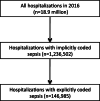Association between sepsis incidence and regional socioeconomic deprivation and health care capacity in Germany - an ecological study
- PMID: 34493250
- PMCID: PMC8424852
- DOI: 10.1186/s12889-021-11629-4
Association between sepsis incidence and regional socioeconomic deprivation and health care capacity in Germany - an ecological study
Abstract
Background: Sepsis is a substantial health care burden. Data on regional variation in sepsis incidence in Germany and any possible associations with regional socioeconomic deprivation and health care capacity is lacking.
Methods: Ecological study based on the nationwide hospital Diagnosis-related Groups (DRG) statistics data of 2016. We identified sepsis by ICD-10-codes and calculated crude and age-standardized incidence proportions in the 401 administrative German districts. Associations between socioeconomic and health care capacity indicators and crude and age-adjusted sepsis incidence were investigated by simple and multiple negative binomial (NB) regressions.
Results: In 2016, sepsis incidence was 178 per 100,000 inhabitants and varied 10-fold between districts. We found that the rate of students leaving school without certificate was significantly associated with crude and age-standardized explicit sepsis incidence in the simple and multiple NB regressions. While we observed no evidence for an association to the capacity of hospital beds and general practitioners, the distance to the nearest pharmacy was associated with crude- and age-standardized sepsis incidence. In the multiple regression analyses, an increase of the mean distance + 1000 m was associated with an expected increase by 21.6 [95% CI, 10.1, 33.0] (p < 0.001), and 11.1 [95% CI, 1.0, 21.2]/100,000 population (p = .026) after adjusting for age differences between districts.
Conclusions: Residence in districts with lower socioeconomic status (e.g., less education) and further distance to pharmacies are both associated with an increased sepsis incidence. This warrants further research with individual-level patient data to better model and understand such dependencies and to ultimately design public health interventions to address the burden of sepsis in Germany.
Keywords: Ecological study; Incidence; Medical services; Sepsis; Socioeconomic factors.
© 2021. The Author(s).
Conflict of interest statement
The authors declare no competing interests.
Figures



References
-
- Singer M, Deutschman CS, Seymour CW, Shankar-Hari M, Annane D, Bauer M, Bellomo R, Bernard GR, Chiche JD, Coopersmith CM, Hotchkiss RS, Levy MM, Marshall JC, Martin GS, Opal SM, Rubenfeld GD, van der Poll T, Vincent JL, Angus DC. The third international consensus definitions for Sepsis and septic shock (Sepsis-3) JAMA. 2016;315(8):801–810. doi: 10.1001/jama.2016.0287. - DOI - PMC - PubMed
-
- Rudd KE, Johnson SC, Agesa KM, Shackelford KA, Tsoi D, Kievlan DR, Colombara DV, Ikuta KS, Kissoon N, Finfer S, Fleischmann-Struzek C, Machado FR, Reinhart KK, Rowan K, Seymour CW, Watson RS, West TE, Marinho F, Hay SI, Lozano R, Lopez AD, Angus DC, Murray CJL, Naghavi M. Global, regional, and national sepsis incidence and mortality, 1990-2017: analysis for the global burden of disease study. Lancet. 2020;395(10219):200–211. doi: 10.1016/S0140-6736(19)32989-7. - DOI - PMC - PubMed
-
- Bloos F, Thomas-Ruddel D, Ruddel H, Engel C, Schwarzkopf D, Marshall JC, Harbarth S, Simon P, Riessen R, Keh D, et al. Impact of compliance with infection management guidelines on outcome in patients with severe sepsis: a prospective observational multi-center study. Crit Care. 2014;18(2):R42. doi: 10.1186/cc13755. - DOI - PMC - PubMed
-
- Sinapidis D, Kosmas V, Vittoros V, Koutelidakis IM, Pantazi A, Stefos A, Katsaros KE, Akinosoglou K, Bristianou M, Toutouzas K, Chrisofos M, Giamarellos-Bourboulis EJ. Progression into sepsis: an individualized process varying by the interaction of comorbidities with the underlying infection. BMC Infect Dis. 2018;18(1):242. doi: 10.1186/s12879-018-3156-z. - DOI - PMC - PubMed
Publication types
MeSH terms
LinkOut - more resources
Full Text Sources
Medical

